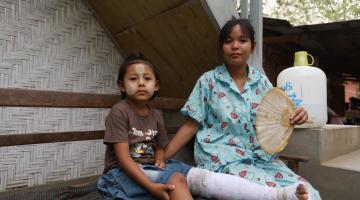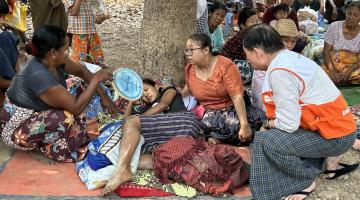10 Facts About How Health Shapes a Child’s Future

Governments and individuals spend billions of dollars every year on health - it’s the bedrock of people’s livelihoods and well-being, and nation’s economies. Here are 10 facts about how health shapes your sponsored child’s ability to learn, grow and break the cycle of poverty.
1. A child’s first years are the building blocks of their health for life
The foundations of lifelong health, productivity and well-being are laid in early childhood – and those foundations are hard to rebuild later in life when a child grows up without basic things like nutritious food, clean water, hygiene and sanitation facilities, or access to healthcare when they are sick, making early intervention critical.
2. A child is at highest risk of dying in the first month of life
Safe childbirth and neonatal care are essential to ensure the lives of our newborns – babies who receive care from trained midwives after birth are 16 percent less like to die. Simple interventions like training birth attendants, educating parents about the importance of breastfeeding, child health and nutrition, and infant growth monitoring can make all the difference – and sponsors’ partner with communities to make this happen.
3. Poverty leads to poor health and premature death in children
Of the world’s 2.2 billion children, one billion children - almost half - live in poverty, where children are more susceptible to disease and infection and are more likely to die as a result of basic hygiene, lack of access to clean water or poor nutrition. Children from the poorest households are twice as likely to die before reaching age five and face increased risk of chronic illness and shortened life expectancy, making support to overcome the root causes of poverty for children, life-altering.

4. The stress of living in poverty harms a child’s brain development
Brain development is most rapid in the initial years of life. The stress of living in poverty can affect a child’s brain development, which makes it harder for a child to engage in healthy activities and relationships and do well in school. By helping children and their families build their livelihoods and their confidence that their basic needs will be met, they are free to play, learn, and live life to their full potential.
5. Poor health can trap children and families in poverty
Poor health is both a cause and an outcome of poverty. People with higher levels of education are more likely to be healthier and live longer. Equally, when people are healthy, they can do more to improve their situation like work and learn. On the other hand, health services and medicines can be expensive, and money spent on health care diverts funds from food, more secure housing and education – all of which are essential to break the cycle of poverty. Research shows children living in poverty often lag behind their more financially secure peers from an early age. They are more likely to drop out of school and also face increased risk of abuse and exploitation, making initiatives that level the playing field so important.
6. Half of the world’s people lack access to health services
At least half of the world’s people cannot access essential health services. That’s millions of families who can’t see a trained health worker when they are sick. Because children are most vulnerable to disease, many die each year from illness that could be easily treated. Child sponsors help communities to improve their healthcare by training local health workers, birth attendants and child health volunteers, equipping local health clinics, and supporting communities to advocate to the local government for improved health services and systems.

7. Immunisation rates have dropped, and 2.2 million children are dying each year without them
Childhood immunisation saves lives – they are a cheap, effective way of helping children to build up their bodies’ natural defences to fight serious disease. But in 2021, global immunisation rates dropped to the lowest rate in over a decade. Access to vaccinations are a key part of sponsorship initiatives to help reverse this trend so children grow healthy and strong.
8. Children’s health is damaged by climate change
Children pay a disproportionately high price for climate change through impacts to their health. Extreme weather events and climate shocks can cause water shortages and impact food supplies and sanitation, driving disease, under-nutrition and under-development, making initiatives that help vulnerable communities build their resilience to climate shocks vital. This includes training on improved agricultural techniques, support for families to diversify their income sources, and help for communities to implement farmer managed natural regeneration programmes, where local forests are cultivated to improve the local environment and provide sustainable income sources such as beekeeping.
9. The world is going backwards globally on child health
While the benefits of child health are more widely known than ever, new research from the World Health Organisation shows progress on indicators of child health have stalled, and are set to reverse unless urgent action is taken. Climate change, pandemic-related impacts, economic slowdown, growing inequality, conflict and pollution are contributing forces.

10. The leading causes of death in young children are preventable
Diarrhea, measles, malaria and pneumonia are leading causes of death among children under five – and they are all entirely preventable. Malnutrition adds to this toll, claiming nearly half of all lives in the same age range. But while the drivers of child health issues can be complex, local solutions are effective in saving lives. By supporting communities to train healthcare workers, improve their agricultural practices, drill water bores or install toilets and taps, teach parents to cook nutritious meals, monitor children’s growth, and so much more, sponsors are stopping children from dying preventable deaths.
Child sponsors are providing three million children and their communities around the world with greater access to healthcare and better nutrition, vaccinations, early intervention and ongoing support to be healthy and thrive in life – and the benefits are life-altering.
Click here to join us on this life-changing journey today!








